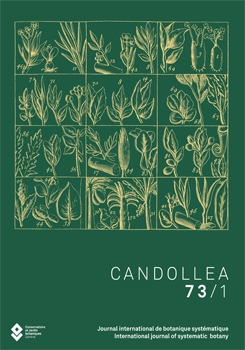Negaresh, K. (2018). A new combination in the genus Cyanus (Asteraceae, Cardueae, Centaureinae). Candollea 73:101–103. In English, English abstract. DOI: http://dx.doi.org/10.15553/c2018v731a9
Cyanus raimondoi (Bancheva & Kaya) Negaresh is proposed as a new combination. It is morphologically similar to Cyanus eflanensis Kaya & Bancheva, but differs from it by the indumentum, the flowering stem, the cauline leaves, and the achenes dimension.
Received: January 21, 2018. Accepted: April 16, 2018. First published online: June 25,2018.
Introduction
The Cyanus group was first described by Miller (1754) as a genus. Subsequently, Candolle (1838) reduced this genus to a section of Centaurea L., a position followed by some botanists (Bentham, 1873; Boissier, 1875; Hoffmann, 1893; Stefanov & Gheorghiev, 1931; Dittrich, 1968; Wagenitz, 1975). Others recognized it as a subgenus of Centaurea (Czerepanov, 1963; Dostál, 1976). Molecular studies of Centaureinae by Garcia-Jacas et al. (2001) and Wagenitz et al. (2006) have shown that the Cyanus group is sister to the genus Centaurea s.s. Currently the most widely-accepted taxonomic position recognizes Cyanus as a separate genus (Soják, 1972; Holub, 1977; Dostál, 1984; Bancheva & Raimondo, 2003; Greuter, 2003, 2008; Hellwig, 2004; Bancheva & Greilhuber, 2006; Wagenitz, 2006; Bancheva & Stoyanov, 2009; Kaya & Bancheva, 2009; Olšavská et al., 2009, 2011; Ranjbar & Negaresh, 2012; Olšavská et al., 2013; Ranjbar et al., 2013a, 2013b; Stoyanov, 2016).
Cyanus Mill. is distributed throughout central and southern Europe, North Africa, Asia Minor, and the Caucasus, with some species appearing as far east as Iran and Afghanistan and currently includes 32 species (Hellwig, 2004; Bancheva & Stoyanov, 2009; Kaya & Bancheva, 2009; Boršić et al., 2011; Ranjbar & Negaresh, 2012; Olšavská et al., 2013; Ranjbar et al., 2013a, 2013b; Stoyanov, 2016). The genus is distinct within the Centaureinae by phyllaries with scarious and spineless appendages that are decurrent nearly to the phyllary base, and by blue or purplish blue florets (with only a few exceptions of cream- or pale pink-flowered taxa) (Wagenitz & Hellwig, 1996; Boršić et al., 2011). This genus has been divided into annual group containing 6 species and perennial group containing 26 species (Olšavská et al., 2013). Annual species show a complex dysploid chromosome series with gametic chromosome numbers x = 8, 9, 10 and 12, whereas perennial species are more uniform in their gametic chromosome numbers, with x = 10 or 11 (Wagenitz & Hellwig, 1996; Uysal et al., 2009; Boršić et al., 2011; Olšavská et al., 2013).
Recently, Bancheva & Kaya (2015) described Centaurea raimondoi Bancheva & Kaya as a new species for the flora of Turkey. They did correctly place it in Cyanus but, as they did not recognize that genus, they included it in Centaurea. According to them, it is closely related to Cyanus eflanensis Kaya & Bancheva. A detailed comparison of the description and type photograph confirms that Centaurea raimondoi belongs to the Cyanus because of its violet-blue florets, peripheral florets radiant and devoid of staminodes, phyllary appendages spineless with scarious margin decurrent nearly to the base. Indeed, in agreement with Bancheva & Kaya's treatment (Bancheva & Kaya, 2015) and the current concept of Cyanus, we propose the new combination. With this species included, the total number of species in Cyanus increases to 33.
Nomenclature and taxonomy
Cyanus raimondoi (Bancheva & Kaya) Negaresh, comb. nova.
= Centaurea raimondoi Bancheva & Kaya in Fl. Medit. 25(special issue): 306.2015.
Holotypus: TURKEY: A3 Bolu: between the cities of Mengen and Pazarköy, on rocky places, 40°55′25″N 32°08′12″E, 13.VI.2012, Bancheva & Kaya 171075 (SOM!; iso-: PAL).
Notes. — Cyanus raimondoi resembles C. eflanensis, which is endemic to Turkey, in life form, involucre size and width of the undivided portion of the scarious phyllary margin, but differs in some important characters such as a densely lanate indumentum, a thickened, 0.7–0.9 cm wide taproot, flowering stem arising laterally at the base of a leaf rosette (vs loosely villous or subglabrous indumentum, a thickened, 1–1.5 cm wide taproot, flowering stem terminal, arising from the centre of a leaf rosette), lower cauline leaves entire to pinnatifid, with 1–2 pairs of lanceolate segments, usually forming a basal rosette at flowering time (vs pinnatifid to pinnatipartite, with 2–4 pairs of lanceolate segments, or entire, usually not forming a basal rosette at flowering time), flowers violet (vs purplish-violet), and ache ne s 2.8–3.5 mm (vs 4–4.5 mm) long (Bancheva & Kaya, 2015).
Acknowledgments
I would also like to thank to Khuzestan Agricultural Sciences and Natural Resources University for financial support.





